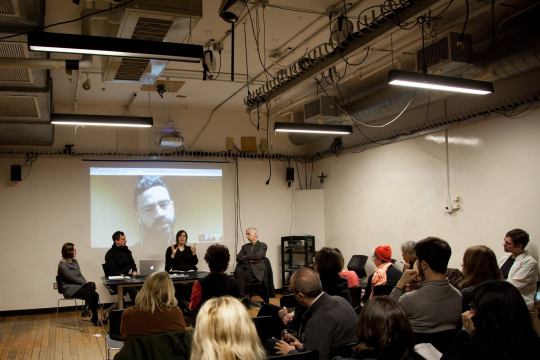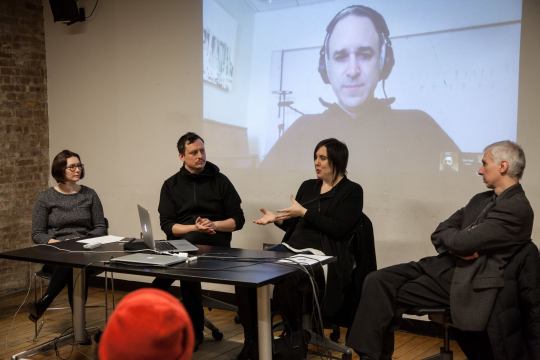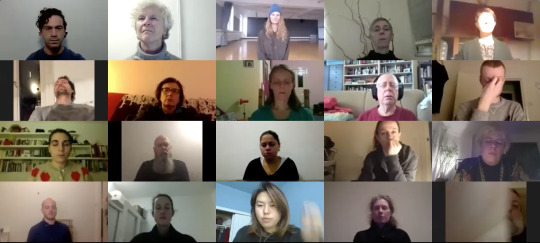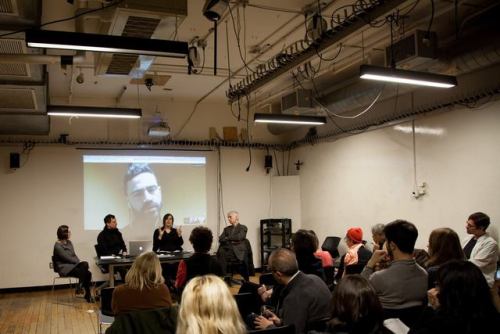#telematic art

“Now, more than ever, we need to get together to explore ways in which the live media can be used to foster action, creativity, and inclusivity!” - REFEST 2.0 / Presented by ITP, CultureHub, and WITNESS at ITP/NYU - 721 Broadway 4th Floor
The State of Telematic Art in 2017 - A Panel Discussion (Billy Clark, Michael Dessen, Daniel Pinheiro, Jesse Ricke, Robert Rowe, Kate Sicchio, & Sarah Weaver)

Check out photos of Refest 2.0 here!
Some thoughts on The State of Telematic Art:
From the early experiments on satellite connections to allow the bringing together of distant remote locations into one same (shared) space until nowadays seamless use of online tools that almost invisibly bring together users from any location into the same room, Telematic Art has been exploring the way technology – and more specifically networked environments – shapes human interaction.
The possibility of dissipating time and distance in projects from artists like Kit Galloway, Paul Sermon or in the thoughts of Roy Ascott has been a major concern towards the development of ‘structures’ that often reflect upon the human impossibility of ubiquity.
In projects like LAND PROJECT or, within that one, the more recent, in collaboration with Annie Abrahams, Distant Feeling(s) the main goal is to deconstruct the sense of co-presence in the same time and space and traduce it / materialize it into actions that are (possible) models of re-thinking our agency in a networked society and within the digital sphere.
Either by experimenting ‘moving’ together with someone that is not in the same space as you, but that becomes present through mediation or trying to perceive the presence of ‘others’ in the network by creating a moment of silence and stillness where we’re left alone in front of our computers but as a group, the art object becomes complete in the intersection space; often the output (the format in which the result is shown) – the same surface used for the process of mediation to happen.
Although networked practices find at its core, with the developments made over the last decade on having the tools more accessible to the practitioners, the possibility of building connections between artistic communities and bringing them together in a more sustainable way providing a medium that beyond allowing connection facilitate collaboration, these practices deal with characteristics of the environment in which they happen and elaborate on ways to approach them and shape the methologies of artistic production. The perception of synchronicity in projects like the one’s of Sarah Weaver is one of the many aspects included in the way our body and brain perceive this context which is a specific space for which a specific type of art is being developed.
Thinking about the space where Telematic Art happens is to re-think a space/place and developing tools that widen the potential of the practices related to it. Either it is by connecting human-to-human through the machines, input external live data that disrupts the ‘normal’ (organic) way of moving and/or behaving or, as an example, investigate latency as part of music composing where sounds travel across distant locations and how all of this is (also) a consequence of living in the digital age, transforms telematics into a process of thinking the world we live, acknowledging that we are not constricted to our own contexts but that we can (more easily) reach out and build significant discourses about possible futures – an extension of what we are now.
To be thinking and practicing Telematic Art was and it is about reformulating the present by overcoming (and troubleshooting) impossibilities allowing our perception about the world to change.
Youngblood reiterates the ethical responsibility of artists to utilize telecommunications in a socially constructive manner, but is skeptical of how early telematic artworks merely repeated what had become common commercial practices. “A communications revolution is not about technology; it’s about possible relations among people,” he observes, arguing that this revolution has the potential to invert extant social relations, transforming the centralized, hierarchical structure of geographically discrete nations into one of decentralized, but politically significant, communities defined by “consciousness, ideology and desire.” (…) the artistic use of telecommunications is “special” (i.e., art as opposed to nonart) only if the media are employed in a way that is not “done every day in business and industry,” and therefore “given, obvious, routine, … [and] politicized.”-‘Roy Ascott, Telematic Embrace - Visionary Theories of Art, Technology, and Consciousness’
“Now, more than ever, we need to get together to explore ways in which the live media can be used to foster action, creativity, and inclusivity!” - REFEST 2.0 / Presented by ITP, CultureHub, and WITNESS at ITP/NYU - 721 Broadway 4th Floor | March 5th, 2017
The State of Telematic Art in 2017
A Panel Discussion (Billy Clark, Michael Dessen, Daniel Pinheiro, Jesse Ricke, Robert Rowe, Kate Sicchio, & Sarah Weaver)
Check out photos of Refest 2.0 here!
Some thoughts on this here
Post link
Distant Feeling(s) #7 | December 7th, 6PM GMT+1
Distant Feeling(s) 7th, activated on December 7th, 2019, was the third annual activation of the Distant Feeling(s) project, inviting all interested to participate in a shared moment of togetherness across a distance.
Using the internet’s potential of connectivity as a means to reflect on the constraints and limitations of that precise quality, DF has become (since its first iteration in 2015*) a participatory event in which through silence and provoking an inwards movement by the closing of the eyes while connected, which aims to highlight the relational aspect that is (supposedly) intrinsic to the idea of network. Throughout its various activations, from a closed environment between the artists Annie Abrahams, Lisa Parra and Daniel Pinheiro – where the main focus was to attempt sensing the existence and presence of the others while being physically distant, without speaking and with eyes closed – to it becoming a practice shared with an audience, and transforming into an open event since 2017, the project has addressed, cumulatively, the characteristics of the medium/infrastructure to reflect upon them, producing an archive of documentation of the various moments where each one and all work as a visual metaphor of the condition(ing) of connectivity as it is installed in our lives.
A silent, yet sentient, relational encounter, materialized as a telematic embrace where nothing seems to happen and where the lack of apparent action has transformed into the transposition of the concept of agency and a potential way for fighting alienation.
In the more recent activations of the project, a common fact has been the awareness of how machines and the surrounding environments from the different remote locations become present* while the bodies perform a sort of absentia while electricity powers this moment of communion. Where and how are we (always) while the network is functioning?
As it continues to develop, iteration after iteration, whether it is through the annual re-activations or in specific contexts it becomes clear that it is a form of researching togetherness through the internet as a way to counter its fallacy, the promise of a interconnected world where concepts of time and physical space dissipate** (an ubiquitous spatio-temporal unity), which in fact drives today the (im)possibility of collective strength/power. It is a provocation to the role of networked conversations as a practice for activism emptied from specific purpose, again, assuming the role of symbolizing a situation of engaging in different possibilities of triggering collective agency.
Can we find novelty in an already established system, and act from within, towards (an)other purpose(s)?
Distant Feeling(s) highlights in its genesis and continuity the need to feel/sense presence and suggests a pragmatical approach for reshaping a consciousness on kinship resorting to available technological tools which have been transforming its meaning.
“Silence is hard to find…” Camille Renarhd mentions at the end of DF#7 and it is through this quest for silence where machines, responsible for allowing the connection across a distance, “speak” louder and the contemporary restlessness is confronted in this model of interaction between humans and machines. It is not a proposition for a revolution nor a resolution for an evident relational crisis, it is an experience on connectivity and its fundamentals.
The relational revolution is already far along.
At the same time, it is clearly in crisis. – Time Reborn p. xxix

Distant Feeling(s) is a project initiated by Annie Abrahams, Lisa Parra and Daniel Pinheiro
Participants of Distant Feeling(s) #7: Camille Renarhd, Daniel Pinheiro, Muriel Piqué, Annie Abrahams, Bérénice Belpaire, Nicolaas Schmidt, Christine Develotte, Sandra Sarala, Alan Sondheim, Paul Hughes, Nerina Cocchi, Frans Van Lent, Ariane Cassimiro, Frédérique Santune, Camille Bloomfield, Jonathan Chomko, Csenge Kolozsvári, Sabrina Kwong, Ienke Kastelein, Molly Hankwitz, David Cox
Will you dance with me?! (2017) [Porto, Portugal - Berlin, Germany]
2017.02.17 – Vorspiel Transmediale 2017 organized by Flee Immediately! (in collaboration with Joana Chicau) at Panke Gallery

Telematic experience using videoconferencing online tools and broadcasting software, this work addresses (and continues) the possibilities investigated over the course of three years, along with artist Lisa Parra, in LAND PROJECT.
This first experiment that took place at Transmediale Vorspiel 2017 intended testing computer performance and audience reaction towards the development of a durational experience.

Photo by Franco Dubini
Following the work developed within LAND PROJECT and more specifically the practice of combining two remote locations in the same frame, the main purpose is to perceive the computer screen as the intersection point where remote bodies find ways to engage in a dance/movement together, experimenting on adjusting one’s position, location and sense of presence while physically separated.
One-on-one participants are invited to dance lonesomeness together to the sound of a version of Elvis Presley’s “Are You Lonesome Tonight”.
Also interested on starting to address the subject of distributed location of the self this work is also included on Daniel Pinheiro’s project TRANSCODING - a series of works dedicated to explore the internet, its affections, and representations of human agency in a multiplied, transitory and fractalized nature.
More on the event:
This experiment was possible through the invitation of Joana Chicau – Media designer, researcher and performer – to be part of the program developed by Flee Immediately! for Vorspiel Transmediale 2017, presenting a series of workshops and performances at Panke exploring and experimenting with choreographic relations and code, from bodies of code to actual bodies, from digital deviations to physical ones. The event series was part of a larger collaboration and research around the relationships between dance, bodies, and code that began in Flee Immediately! issue 02.
For the development:

Technical details:
- [Remote Country]: computer, webcam*, internet connection, zoom.us (software installed), sound speakers on, video projector.
- [Country of origin]: computer, webcam, internet connection, zoom.us (software installed), second monitor, OBS (open broadcaster software),
*the webcam (in-built or usb) should be facing an empty space with a chair (like in the image), preferably white, empty space / The video projection should be opposite to where the participant is standing in order to view in a larger image the combination of the two feeds.
Instructions:
Each participant is invited to seat on the chair and “dance” remotely with the artist(s). The sound cues will inform the participants and the artist(s) will be waiting for the next one. The performance will run for 1hour.
Links:
Joana Chicau – Media designer, researcher and performer:
Flee Links:
http://www.fleeimmediately.com/
http://www.fleeimmediately.com/vorspiel-2017.html
https://www.facebook.com/fleeimmediately/
https://www.instagram.com/fleeimmediately/
Facebook Events:
https://www.facebook.com/events/1758715944451117/
https://www.facebook.com/events/1843160069273071/
Transmediale Vorspiel


